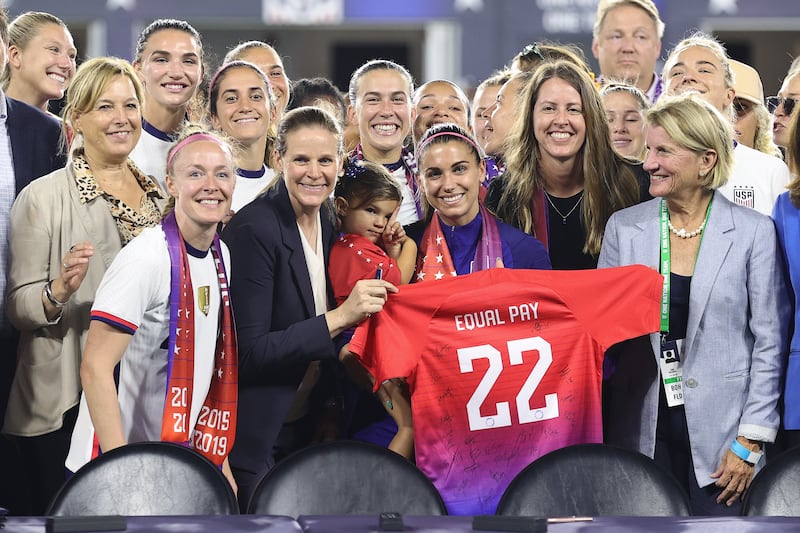As someone who travels frequently by train in the United States, one of the unexpected features to be seen, passing through suburbs and small towns, is the number of soccer goals.
Some are in schools, others in parks. Not always full-size pitches, perhaps more often facilities for five-a-side or children’s games.
From being, in the past, a very niche sport in the US, the “beautiful game” has come a long way.
A popular domestic men’s league as well as TV exposure has, of course, helped. Live games from the Premier League in the UK can be seen on weekend mornings, the Uefa Champions League on midweek afternoons.
READ MORE
Women’s soccer, in particular, is booming.
The women’s national soccer team has been the most successful globally over recent years and has won four World Cup tournaments.
The team also succeeded in a long-running dispute to achieve equal payment with their senior male colleagues.
Our investigation has revealed a league in which abuse and misconduct — verbal and emotional abuse and sexual misconduct — had become systemic, spanning multiple teams, coaches and victims
At grassroots level women’s soccer has grown rapidly over the last 50 years to move in advance of baseball/softball to become the third most-played team game.
About 375,000 woman high school athletes — about 20 per cent — now play soccer.
However, below the surface, in the American women’s soccer league something much darker has been lurking — a culture of abuse, both verbal and sexual, involving some coaches which has now thrown a shadow over the game.
People in Ireland will be all too familiar with the pattern that has emerged from revelations about the sport.
Those who were accused of carrying out abuse moved on from place to place, those making complaints were not listened to while those with knowledge of the allegations about what had taken place remained silent.
A report published earlier this week was damning in its description of the national women’s soccer league (NWSL).

“Our investigation has revealed a league in which abuse and misconduct — verbal and emotional abuse and sexual misconduct — had become systemic, spanning multiple teams, coaches and victims.”
The report drawn up by Sally Yates, a former US acting attorney general, said abuse in the NWSL was “rooted in a deeper culture in women’s soccer, beginning in youth leagues, that normalises verbally abusive coaching and blurs boundaries between coaches and players”.
The report had been commissioned last year by US soccer authorities after media reports set out accusations of verbal and sexual abuse against some coaches in the women’s league.
Certain teams also cloaked information about coach misconduct in attorney-client privilege, non-disclosure agreements, and non-disparagement clauses
These initial revelations led to protests by players, the postponement of some games and the departure of a number of executives.
Some teams and former officials provided little or no co-operation with the investigation which reported this week.
Nevertheless its findings are powerful.
“The verbal and emotional abuse players describe in the NWSL is not merely ‘tough’ coaching. And the players affected are not shrinking violets. They are among the best athletes in the world. They include members of the US women’s national team, veterans of multiple World Cup and Olympic tournaments.”
“In well over 200 interviews, we heard report after report of relentless, degrading tirades; manipulation that was about power, not improving performance; and retaliation against those who attempted to come forward. Even more disturbing were the stories of sexual misconduct. Players described a pattern of sexually charged comments, unwanted sexual advances and sexual touching, and coercive sexual intercourse. ”
The executive summary of the report opens with a shocking account of one player being called to a meeting her team coach in April 2021 to review the video of her performance in a previous game.
It says the coach told the player he was going to touch her for every misplaced pass she had made during the game.
The report says that abuse of woman players had been going on in women’s soccer before the establishment of the current league — even at elite youth level.
“Fraternisation — between players, players and coaches, and players and staff — was common.”
However it says that the current league and overall soccer authorities failed to take any steps to protect players from these problems.
It says that without basic protections in place the systemic abuse of players followed almost inevitably.
The report says in relation to one coach that although soccer authorities had been alerted to allegations of sexual misconduct every year between 2015 and 2021 “much of the misconduct remained under wraps” until a report was published by The Athletic.
Again in another parallel that will be familiar in Ireland, the report says in general, teams, the league and soccer authorities “appear to have prioritised concerns of legal exposure to litigation by coaches — and the risk of drawing negative attention to the team or League — over player safety and wellbeing.”
“Certain teams also cloaked information about coach misconduct in attorney-client privilege, non-disclosure agreements, and non-disparagement clauses.”
The US soccer federation said the findings of the investigation were “heartbreaking and deeply troubling” and promised to take steps to ensure a safe environment.
However, soccer still faces great competition as it tries to muscle in on the more traditional US sports such as football, baseball, basketball and hockey. One wonders how parents who currently drop their children off at the pitches seen by railway lines will react to the horrendous revelations in the report this week?















